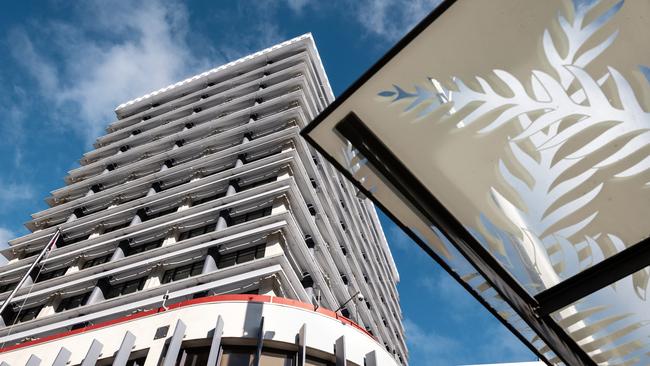Aussie dollar drops to decade low after Reserve Bank of New Zealand slashes rates
A New Zealand rate cut has sent the Aussie below US67c for the first time since 2009, with tips it could fall as low as US65.50.

The Australian dollar has dived to a fresh decade low after the Reserve Bank of New Zealand cut interest rates by more than expected and raised the spectre of negative rates.
And it could fall further, with the National Australia Bank saying the plunge could take the Aussie as low as US65.50c.
Economists were surprised after the RBNZ slashed its cash rate by 50 basis points to a record low of 1 per cent versus market expectations of a 25 basis point cut.
The Australian dollar dived more than 90 points after the RBNZ announced its interest rate decision at noon (AEST).
The Aussie tumbled to US66.78 cents — down more than 0.9 per cent from its New York close at US67.61c — amid increasing bets of further rate cuts by the Reserve Bank of Australia.
It later recovered to US67.14c in afternoon trade.
NZDUSD vs AUDUSD..AUDUSD through flash crash low..rates now pricing a 67.8% chance of a 25bp cut on 3 Sept from the RBA pic.twitter.com/bsNhYQaOYp
— Chris Weston (@ChrisWeston_PS) August 7, 2019
In his address following the decision, governor Adrian Orr said it was “easily in the realms of possiblity that we might have to use negative rates” but that today’s 50bps cut reduced the risk of that outcome.
The market implied chance of a 25 basis point cut by the RBA next month rose to 70 per cent from 53 per cent a day earlier.
Australia faces similar challenges to New Zealand in terms as it strives to generate enough economic growth and employment to return inflation to its target band.
Today’s low in the Australian dollar is the lowest since March 2009, the currency having broken US67.41 cent mark tapped during January’s “flash crash”.
NAB’s senior foreign exchange strategist Rodrigo Catril says downward moves are “still the path of least resistance” and the Aussie could go as low as US65.50c, although it’s unlikely to breach the US65.50c level “imminently”.
He says the local currency is“certainly getting a bit unwelcome NZD infection”, and that the “aggressive, proactive RBNZ certainly ups the pressure on the RBA to move”.
“That said, history would suggest the RBA has its own approach based on its own outlook of domestic and global drivers, so the RBNZ cutting aggressively doesn’t mean the RBA will follow,” Mr Catril added.
NAB expects the RBA to cut rates by 25 basis points in November.
New Zealand’s central bank said the escalating global trade tensions and a loss of momentum in the local economy were triggers for its second cut this year.
The central bank had cut the official cash rate by 25 basis points to 1.50 per cent in May, a month before the RBA restarted its own easing cycle.
“Global economic activity continues to weaken, easing demand for New Zealand’s goods and services,” the RBNZ said in a statement.
“Heightened uncertainty and declining international trade have contributed to lower trading-partner growth.
Central banks are easing monetary policy to support their economies,” it said.
New Zealand is highly exposed to the escalating trade war between the US and China, with the New Zealand dollar down by close to 4 per cent versus the US dollar over the last two weeks.
Inflation expectations have been falling while soft business confidence surveys have been pointing to a slowdown in hiring and wage growth pressures.
But the RBNZ gave no hint that it was reacting to international concern about “currency wars” after China’s yuan hit a decade low after the US labelled China a “currency manipulator” this week.
The RBNZ made no mention of “dollar”, “exchange rate” or “currency” its statement or minutes today.
Indeed its large rate cut was more to do with the risks to inflation and growth being “tilted to the downside” amid slowing global growth.
“The Committee agreed that weak global economic conditions could see imported inflation remain low if global growth slows further or if commodity prices decline,” the RBNZ said.
The decision to cut comes despite data released Tuesday that showed unemployment in the second quarter had hit an 11-year low of 3.9 per cent, which economists said will prove to be an aberration.
The RBNZ welcomed the improved employment report, but said wages growth remains soft.
Australia’s Reserve Bank left interest rates unchanged at a record low of 1 per cent at its meeting on Tuesday.




To join the conversation, please log in. Don't have an account? Register
Join the conversation, you are commenting as Logout